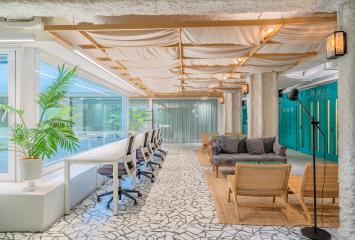Rehabilitation of buildings for a sustainable future
Rehabilitating buildings is key to mitigating the effects of climate change, since they are responsible for 35% of CO₂ emissions worldwide, a percentage that could be reduced if sustainability and energy efficiency measures were incorporated, such as solar panels, innovative materials, lighting systems, etc.
In Europe, the European Green Pact or Green Deal has been presented, which aims to transform the EU into an efficient space in terms of use of resources and whose economy is clean and with zero emissions. The renovation of public and private buildings is an essential action and has been highlighted in the European Green Deal as a key initiative to boost energy efficiency in the sector and meet the objectives and the competitive economy.
At Colonial we have numerous properties that have undergone renovations to include sustainable practices that reduce operating costs and environmental impact, increase the adaptability, durability and resilience of buildings, and adapt to people's lives and needs in a changing world.
Energy efficiency
Reducing energy demand through energy efficiency is one of the most common actions in sustainable renovation processes. This is the case of our Cedro asset, which uses high-efficiency LED lighting with low glare rates, the self-adjustable DALI lighting management and control system, and a BMS system.
Ortega y Gasset 100 has a low-voltage supply for the entire building and partial consumption measurement that allows to have control of lighting, air conditioning and consumption of the different power circuits.
Use of water
Applying cutting-edge technologies to buildings significantly reduces water consumption, an increasingly scarce resource. This is possible, thanks to the reuse of gray water, as well as the use of alternative sources, such as rainwater, which can be used for irrigation, urban cleaning, etc.
Among our assets, the following stand out: Passeig dels Til·lers, 2-6, which uses a gray water recovery and recycling system that allows the building's water consumption to be reduced by 30%; Sant Cugat Nord that reuses rainwater and gray water and has automatic water leak control systems.
Also, in Velazquez86d, water consumption has been reduced by up to 70% thanks to utilitarian technology.
Construction materials
Materials determine the life cycle of a building. Therefore, energy improvement also involves replacing traditional construction materials such as concrete and steel with others that are more sustainable and have a low environmental impact.
For example, the facade of Miguel Ángel 23 has been made using wooden panels instead of a curtain wall, and glass pergolas with photovoltaic panels have been installed on its roof, providing an energy solution with almost zero consumption.
Cedro and Velazquez86d have been built with high recycled content and low emission materials. Ortega y Gasset 100 is a building designed with zero CO₂ emissions, aware of the environment, which uses materials manufactured in compliance with current environmental requirements.
At Colonial, we have a firm commitment to decarbonization and we are strongly committed to a business model that prioritizes the rehabilitation of assets, thanks to which we can offer buildings committed to the environment and spaces that generate greater well-being in people.

